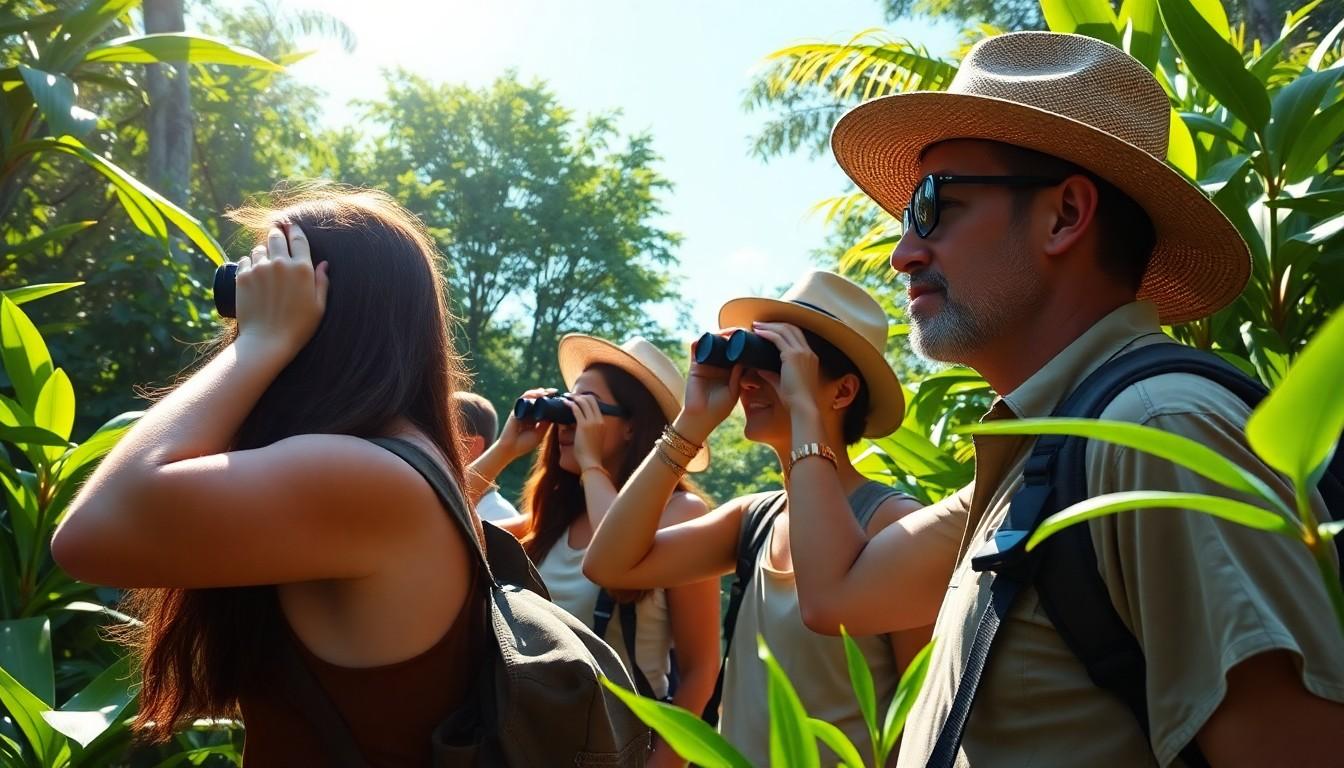Imagine sipping a refreshing coconut drink while surrounded by breathtaking landscapes, vibrant wildlife, and the warm sun kissing your skin. Welcome to eco-tourism in Mexico, where adventure meets sustainability in the most delightful way. This isn’t just a vacation; it’s a chance to embrace nature and leave a positive footprint behind—without stepping on any endangered turtles, of course.
Eco Tourism In Mexico
Eco-tourism in Mexico emphasizes the beauty of natural landscapes while supporting local communities and conservation efforts. This approach encourages travelers to engage with the environment through sustainable practices. Popular destinations include the Yucatan Peninsula, which features cenotes and lush jungles. Travelers can explore the coastline while participating in activities like kayaking and birdwatching, fostering a deeper understanding of local ecosystems.
Biodiversity plays a crucial role in Mexico’s eco-tourism appeal. The country is home to various habitats, from deserts to rainforests, and shelters an array of species. Tourists can participate in guided tours that promote wildlife observation without disturbing their natural environments.
Cultural experiences enrich eco-tourism as well. Visitors often interact with indigenous communities, learning about traditional practices and the importance of environmental stewardship. These interactions not only enhance the travel experience but also help preserve cultural heritage.
Accommodations aligned with eco-tourism values often utilize renewable resources and implement waste reduction strategies. Many eco-lodges offer organic meals made from locally sourced ingredients, further supporting sustainability.
Compliance with eco-tourism guidelines enhances environmental protection. Initiatives actively promote responsible travel choices, reducing carbon footprints and conserving water. Visitors who prioritize eco-friendly practices contribute positively to Mexico’s diverse ecosystems and the wellbeing of local communities.
Overall, eco-tourism in Mexico offers a unique blend of adventure and responsibility, inviting travelers to explore while safeguarding the environment for future generations.
Popular Eco Tourism Destinations

Mexico offers diverse eco-tourism destinations that combine natural beauty and sustainable practices. Travelers can explore stunning landscapes while supporting conservation efforts.
The Riviera Maya
The Riviera Maya spans from Cancun to Tulum and features pristine beaches and lush jungles. Visitors experience activities like snorkeling in cenotes and exploring coral reefs, which provide habitat for marine life. Eco-friendly resorts dotted along the coastline focus on sustainability, offering locally sourced cuisine and tours that educate guests about marine conservation. Wildlife enthusiasts can spot various species, including sea turtles and exotic birds. This area promotes a deep connection with nature while supporting local communities.
The Copper Canyon
The Copper Canyon presents breathtaking views and vast biodiversity. Known for its dramatic cliffs and rich flora, this destination provides visitors with opportunities for hiking and guided tours. Local Tarahumara communities invite travelers to learn about their traditions and sustainable farming practices. Adventure seekers can enjoy the scenic railway that passes through the canyon, highlighting the area’s ecological significance. Eco-tourists actively contribute to conservation efforts, ensuring the preservation of this remarkable landscape.
Oaxaca’s Natural Wonders

Oaxaca is renowned for its diverse ecosystems, including mountains and coastal areas. Tourists can explore the UNESCO World Heritage site of Sierra Norte, which offers eco-trails and cultural tours with local guides. Culinary experiences showcase traditional Oaxacan cuisine made from organic ingredients sourced from local farmers. Birdwatching in the Pacific Coast region reveals over 400 species, making it a prime spot for enthusiasts. Engaging with indigenous communities ensures a mutually beneficial relationship that enhances environmental awareness and promotes responsible tourism.
Activities In Eco Tourism Mexico
Eco-tourism in Mexico offers a variety of activities that enhance the travel experience while promoting sustainability.
Wildlife Observation
Observing wildlife takes center stage in eco-tourism. Guided tours focus on local biodiversity, allowing travelers to spot unique species in their natural habitats. Locations like Sian Ka’an Biosphere Reserve provide opportunities for turtle watching and birding, showcasing over 300 species. Travelers interested in marine life can participate in whale watching tours off the Baja California coast. Responsible wildlife observation ensures minimal disturbance to animals, contributing to ongoing conservation efforts.
Sustainable Agriculture Tours
Sustainable agriculture tours present an engaging way to learn about local farming practices. Visiting organic farms offers insights into traditional methods and permaculture techniques. Participants may harvest fruits and vegetables while discovering the importance of sustainable farming for local ecosystems. Regions like Chiapas and Oaxaca feature tours that promote indigenous agricultural methods, enhancing understanding of food systems while supporting local economies. Engaging in these tours deepens connections with the land and its caretakers.
Cultural Experiences
Cultural experiences in eco-tourism allow for rich interactions with indigenous communities. Travelers participate in workshops that highlight traditional crafts, cuisine, and rituals. These experiences foster an appreciation for local cultures while emphasizing environmental stewardship. Areas like Oaxaca offer opportunities to learn about ancient practices in sustainable agriculture and natural medicine. Engaging with local artisans and farmers strengthens community ties and supports preservation of cultural heritage, creating a truly immersive experience.
Benefits Of Eco Tourism
Eco-tourism in Mexico offers numerous benefits, particularly in environmental conservation and community development. These advantages foster sustainable practices while enriching the travel experience.
Environmental Conservation
Engaging in eco-tourism directly contributes to environmental conservation efforts. Travelers support initiatives to protect endangered species and their habitats. Guided tours often emphasize minimal disturbance to wildlife, allowing natural ecosystems to thrive. Notably, places like Sian Ka’an Biosphere Reserve showcase the importance of biodiversity and the role of sustainable practices. Sustainable tourism initiatives reduce the carbon footprint, promoting renewable energy and waste management. Many eco-friendly accommodations utilize local materials and renewable resources, ensuring a lighter footprint. Visitors often participate in reforestation projects or marine conservation activities, further amplifying their positive impact on the environment.
Community Development
Eco-tourism actively promotes community development in various regions across Mexico. Local economies benefit from travelers who prioritize authentic experiences over commercialized tourism. Communities receive resources through sustainable tourism initiatives, leading to improved education and healthcare access. By partnering with indigenous groups, eco-tourism creates platforms for cultural exchange and knowledge sharing. Visitors gain insights into traditional practices, fostering mutual respect and appreciation. Moreover, collaborations often provide fair wages for locals, enhancing their livelihoods while preserving cultural heritage. Engaging in local workshops and activities enables tourists to contribute to the community’s growth genuinely.
Challenges Facing Eco Tourism In Mexico
Eco-tourism in Mexico encounters significant challenges that impact its effectiveness in promoting sustainable travel. Over-tourism and insufficient conservation efforts contribute to the complexities surrounding this industry.
Over-Tourism
Over-tourism threatens eco-tourism by straining natural resources and ecosystems. Popular sites, like the Riviera Maya, face congestion during peak travel seasons, leading to habitat degradation. Crowds disrupt wildlife habitats and increase pollution, harming local flora and fauna. Stakeholders must address visitor limits and implement sustainable practices while managing visitor flows. Destinations can promote lesser-known sites to alleviate pressure on popular areas, encouraging responsible travel.
Conservation Efforts
Conservation efforts struggle with funding and resources, ultimately affecting community initiatives. Local organizations often require financial support to engage in effective conservation projects. Collaboration among government bodies, NGOs, and eco-tourism operators fosters resource sharing and combined programs. Educating travelers on the significance of biodiversity and conservation enhances awareness and encourages responsible behavior. Prioritizing community involvement in conservation attracts local support, driving initiatives that protect natural habitats while benefiting local economies.
Sustainable Future for Mexico
Eco-tourism in Mexico offers an incredible opportunity for travelers to immerse themselves in nature while making a positive impact. By choosing eco-friendly practices and supporting local communities, visitors can enjoy breathtaking landscapes and rich biodiversity without compromising the environment.
Engaging with indigenous cultures and participating in sustainable activities enriches the travel experience and fosters a deeper appreciation for the region’s natural heritage. As travelers embark on their eco-adventures, they contribute to vital conservation efforts and help ensure that these beautiful destinations remain preserved for generations to come. Embracing eco-tourism not only enhances personal journeys but also plays a crucial role in promoting a sustainable future for Mexico.

